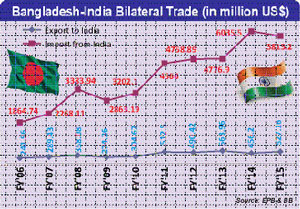
Playing by rules of the game
Syful Islam | Sunday, 22 November 2015

India is the closest and most important neighbour of Bangladesh. It is also a major trading partner of the country. Bangladesh is highly dependent on India for import of various food and non-food items, after China. The bilateral trade between Bangladesh and India has already reached over US$ 6.0 billion.
However, the trade volume is highly titled towards the Indian side. Bangladesh's export to India still hovers around $ 500 million despite the neighbouring giant opening its market for least developed countries some years back.
Economists and traders see India's non-tariff barriers a major reason for Bangladesh's low volume of export to India. Bangladesh has been requesting India for years to remove the barriers to let it raise exports and help reduce the ever rising trade gape between the two countries without any result. Rather, the giant neighbour is continuing to tighten a throttling noose around the neck of Bangladesh's export there.
India is also continuing to create pressure on Bangladesh one after another to open its border. During the last visit of Prime Minister Narendra Modi, India could ensure that Bangladesh let it use its territory to carry goods to North Eastern Indian states. The country already enjoyed on several occasions the transhipment facility and used Bangladesh's territory to carry goods to the seven sister states. Now it is securing the transit facility which is set to start.
Bangladesh has also agreed to let India use its two seaports -- Chittagong and Mongla-- to carry goods to various Indian states. The ministry of shipping is taking necessary preparations so that Indian goods-laden vessels can get at least window berthing aiding quicker loading and unloading of goods.
During Mr Modi's visit India again offered Bangladesh another $2.0 billion credit but tagged with it various harsh conditions, which officials now find very difficult to maintain. Recently India made it clear that it would not soften any conditions set earlier for the said line of credit.
A major condition is minimum 75 per cent of goods and services have to be of the Indian origin and must be procured from India under the credit. The credit will create 50,000 jobs in India, as the goods and services are mandatorily required to be procured from there.
As part of its move to raise its export here India recently requested Dhaka to cut import duty on salt and sugar so that its traders can enter Bangladeshi market with a greater competitiveness. It said the import duty on salt in Bangladesh is very high, hampering access of its traders to the market here with the commodity. The Indian request came at a time when the country imposed a new non-tariff barrier on export of Bangladeshi jute and jute goods to its market.
On September 10 in a notice the Jute Commission of India cancelled registration of Indian importers of raw jute and jute products and made mandatory fresh registration at the importer, buyer and user levels. It also asked importers to have no-objection certificates (NoCs) for each consignment from the Jute Commissioner of India and submit details about the buyers of the imported consignments while applying for NOCs. The directive had created a big barrier to Indian import of jute and jute goods from Bangladesh.
In the face of strong protest from Bangladesh later India slightly softened the new conditions set by the jute commissioner. In a new notice it exempted jute importers from collecting NoCs from the office of the Jute Commissioner against each consignment of goods and omitted the paragraph of a previous notification which had stated that imported raw jute and jute yarn would not be used in manufacturing sacks which are used for packaging commodities..
But the new notification did not exempt importers, traders and end-users from getting registered with the jute commissioner's office. It asked the people concerned to ensure that the entire chain from the import to the level before the end users shall be registered with the jute commissioner to facilitate tracking of such materials.
Bangladesh found such conditions as a non-tariff barrier. And recently India started investigating allegations of dumping jute goods and hydrogen peroxide (H2O2) by Bangladesh without following SAFTA rules. Under the rules, India is bound to let Bangladesh discuss the issue before initiating investigation into the allegation of dumping.
In this case New Delhi has turned down a request made by Dhaka to allow it to consult as per rules of SAFTA (South Asian Free Trade Area) agreement. Under the Article 11 (A) of the SAFTA (South Asian Free Trade Area) before considering anti-dumping measures against least-developed contracting states the countries have to be given the scope of consultation in this regard.
The Article reads: "The Contracting States shall give special regard to the situation of the Least Developed Contracting States when considering the application of anti-dumping and/or countervailing measures. In this regard, the Contracting States shall provide an opportunity to least developed contracting states for consultations.
The Contracting States shall, to the extent practical, favourably consider accepting price undertakings offered by exporters from least developed contracting states. These constructive remedies shall be available until the trade liberalisation programme has been completed by all Contracting States."
Though India has offered duty-free market access to Bangladeshi products, the country is found very much non-cooperative to the trading partners. It creates various non-tariff and para-tariff barriers to stop entry of goods of other countries in its market. Such behaviour from a neighbouring giant is not expected in any way. The country should let the economy of small neighbours flourish which will ultimately bring peace in this sub-region.
The writer is a Senior Reporter of The Financial Express.
syful-islam@outlook.com